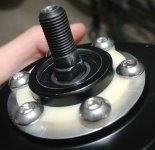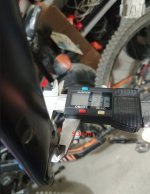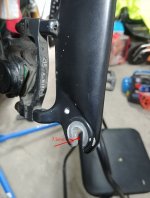flathill said:I wonder if the flat head taper causes the fastener to stretch and loosen given the back and forth torque creates a wedge lever.
Yeah, I think there's a high chance that the countersink wasn't helping things at all and me and Robbie had talked about this. Unfortunately the design requires a flush mounted screw head since it goes up flat to the inside face of the dropouts; there just isn't the space for a normal socket head or the meat to do a recessed socket head (arm piece is just 1/8" thick).
Look at ur disc brake rotors on ur bike. No taper on the screws
That is totally true, but then the disk brakes only have to experience torque in one direction so disk rotor rotates until the side of the holes bottoms out against each screw and then stays there. If you were to take a bicycle disk rotor and give it backwards and forwards torque of +- 100 Nm like this, then my bet is that the screws on that would loosen up pretty quick as well.
I suppose we've got the machine here to test that! But priority for how will be getting torque arm results.






